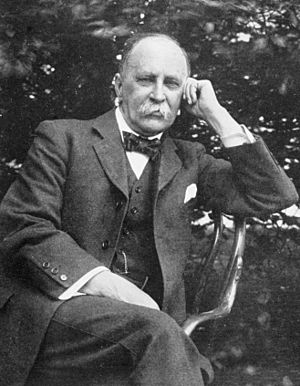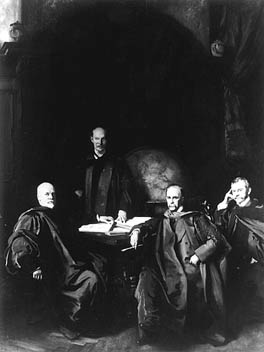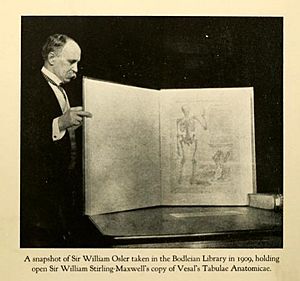William Osler facts for kids
Quick facts for kids
Sir William Osler
|
|
|---|---|

Photograph of Osler, c. 1912
|
|
| Born | July 12, 1849 Bond Head, Province of Canada
|
| Died | December 29, 1919 (aged 70) Oxford, England
|
| Nationality | Canadian |
| Alma mater | Trinity College, Toronto McGill University (MDCM) |
| Known for | co-founding physician of Johns Hopkins Hospital |
| Spouse(s) | Grace Revere Osler |
| Children | 2 sons |
| Scientific career | |
| Fields | Physician, pathologist, internist, educator, bibliophile, author and historian |
| Institutions |
|
| Signature | |
 |
|
Sir William Osler (born July 12, 1849 – died December 29, 1919) was a famous Canadian doctor. He is often called the Father of Modern Medicine. He was one of the four main doctors who started Johns Hopkins Hospital.
Osler changed how doctors are trained. He created the first residency program. This program gives doctors special training after medical school. He also was the first to bring medical students out of classrooms. He had them learn by working directly with patients. Besides being a doctor, Osler loved books and history. He also enjoyed playing practical jokes!
Contents
About William Osler's Life
His Family and Early Years
William Osler's great-grandfather was a merchant seaman. His father, Featherstone Lake Osler, was a former officer in the British Navy. In 1831, Featherstone was asked to join the famous ship HMS Beagle. This ship sailed with Charles Darwin to the Galápagos Islands. But Featherstone had to say no because his father was very ill.
Later, Featherstone became a minister. He moved to Canada with his wife, Ellen Free Picton. They had several children, including William. William Osler was born in Bond Head, Canada West (now Ontario), on July 12, 1849. He grew up in Dundas, Ontario.
William's Education and Medical Path
When he was young, William thought about becoming a priest, like his father. He went to Trinity College, Toronto. But he became very interested in science and medicine. Two mentors, James Bovell and Reverend William Arthur Johnson, encouraged him. They helped him decide to become a doctor instead.
In 1868, Osler began studying at the Toronto School of Medicine. He later moved to McGill University in Montreal. He earned his medical degree in 1872.
Starting His Medical Career
After finishing his studies, Osler went to Germany for more training. In 1874, he returned to McGill University as a professor. There, he started the first "journal club." This was a group where doctors discussed new medical articles. He also taught about animal diseases to help doctors understand human illnesses better.
In 1884, he became a professor at the University of Pennsylvania in Philadelphia. He was known for his calm and steady approach to medicine. In 1889, he moved to Baltimore, Maryland. He became the first head doctor at the new Johns Hopkins Hospital.
Osler quickly became famous for being a great doctor, a kind person, and an excellent teacher. He helped create the Johns Hopkins School of Medicine in 1893. He became one of its first professors of medicine. The hospital grew a lot while he was there.
In 1905, Osler moved to Oxford, England. He became a very important professor of medicine at Oxford University. He stayed in this role until he passed away. In 1911, he was given the title of baronet for his great work in medicine. This meant he was called "Sir William Osler."
Osler's Impact on Medicine
How He Changed Medical Training
One of Osler's biggest ideas was that students should learn by seeing and talking to patients. He believed that doctors should spend time at the patient's bedside. This was a new idea at the time. He said, "He who studies medicine without books sails an uncharted sea, but he who studies medicine without patients does not go to sea at all."
He also started the medical residency system. In this system, doctors in training live and work at the hospital. They learn by taking care of patients every day. This idea spread around the world and is still used today. Osler wanted his tombstone to say, "He brought medical students into the wards for bedside teaching."

His Writings and Books
Osler wrote many books and articles. His most famous book was The Principles and Practice of Medicine. This book became a very important guide for medical students and doctors. It was published for many years and translated into many languages.
He also wrote many essays that helped guide doctors. One of his most famous essays was called "Aequanimitas." This word means being calm and steady, even in difficult situations. This idea was very important to Osler.
Osler loved collecting old books about medicine. He gave his large collection of books to McGill University. This collection became the Osler Library of the History of Medicine. It is now a very important library for medical history in Canada.
Personal Life
His Personality and Family
Osler was known for being a bit of a prankster. He sometimes wrote funny articles under a fake name, "Egerton Yorrick Davis." He would even sign this fake name in hotel registers!
He was a big fan of a 17th-century doctor and thinker named Sir Thomas Browne.
Osler passed away on December 29, 1919, in Oxford, England. He was 70 years old. He likely died from problems related to a lung condition during the Spanish flu outbreak.
He had two sons. One died shortly after birth. The other, Edward Revere Osler, died during World War I at age 21. He was hurt in battle in 1917. This loss was very hard for Osler.
William and his wife, Grace, are buried at the Osler Library at McGill University.
Things Named After Osler
Medical Conditions and Signs
Many medical conditions and signs are named after Sir William Osler because of his discoveries:
- Osler's sign: A way to check blood pressure in some older patients.
- Osler's nodes: Small, painful bumps on fingers or toes. They can be a sign of a heart infection.
- Osler–Weber–Rendu disease: A condition that causes small blood vessel problems.
- Osler–Vaquez disease: Another name for a blood disorder called Polycythemia vera.
- Osler–Libman–Sacks syndrome: A heart condition linked to a disease called lupus.
Buildings and Places
Many places are named after him to honor his contributions:
- Osler Building at Johns Hopkins Hospital in Baltimore.
- Sir William Osler Elementary Schools in Vancouver, British Columbia, Winnipeg, Manitoba, and Dundas, Ontario.
- Osler Library of the History of Medicine at McGill University in Montreal.
- William Osler Health System near Brampton, Ontario.
- Osler House at Oxford University for medical students.
Awards and Honors
There are also awards and lectures named in his honor:
- The William Osler Medal from the American Association for the History of medicine.
- The William Osler Medical Students Essay Awards at the Osler Library.
See also
 In Spanish: William Osler para niños
In Spanish: William Osler para niños


